Wastes in Building Materials Industry -
VerifiedAdded on 2022/09/09
|9
|1603
|11
AI Summary
Contribute Materials
Your contribution can guide someone’s learning journey. Share your
documents today.
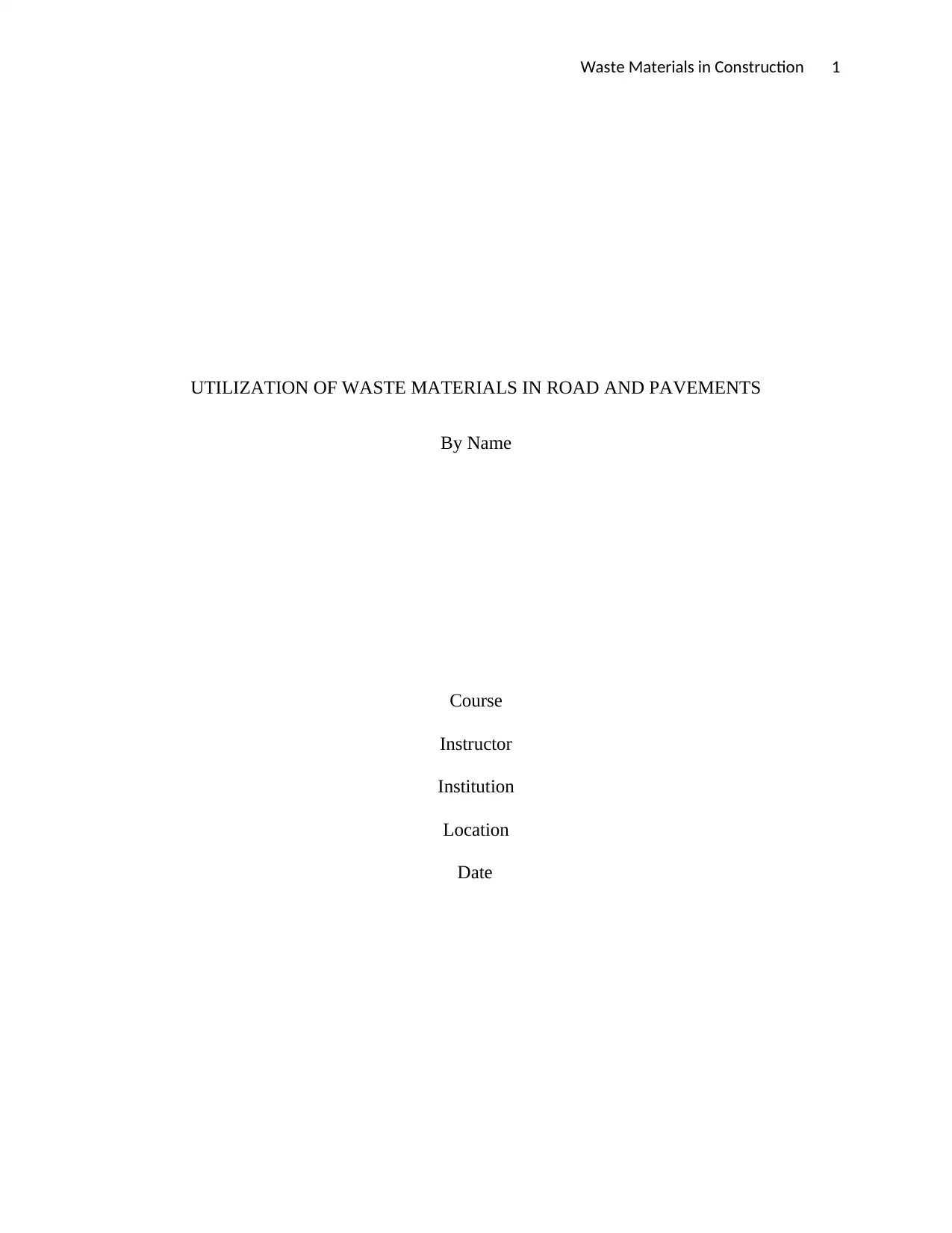
Waste Materials in Construction 1
UTILIZATION OF WASTE MATERIALS IN ROAD AND PAVEMENTS
By Name
Course
Instructor
Institution
Location
Date
UTILIZATION OF WASTE MATERIALS IN ROAD AND PAVEMENTS
By Name
Course
Instructor
Institution
Location
Date
Secure Best Marks with AI Grader
Need help grading? Try our AI Grader for instant feedback on your assignments.
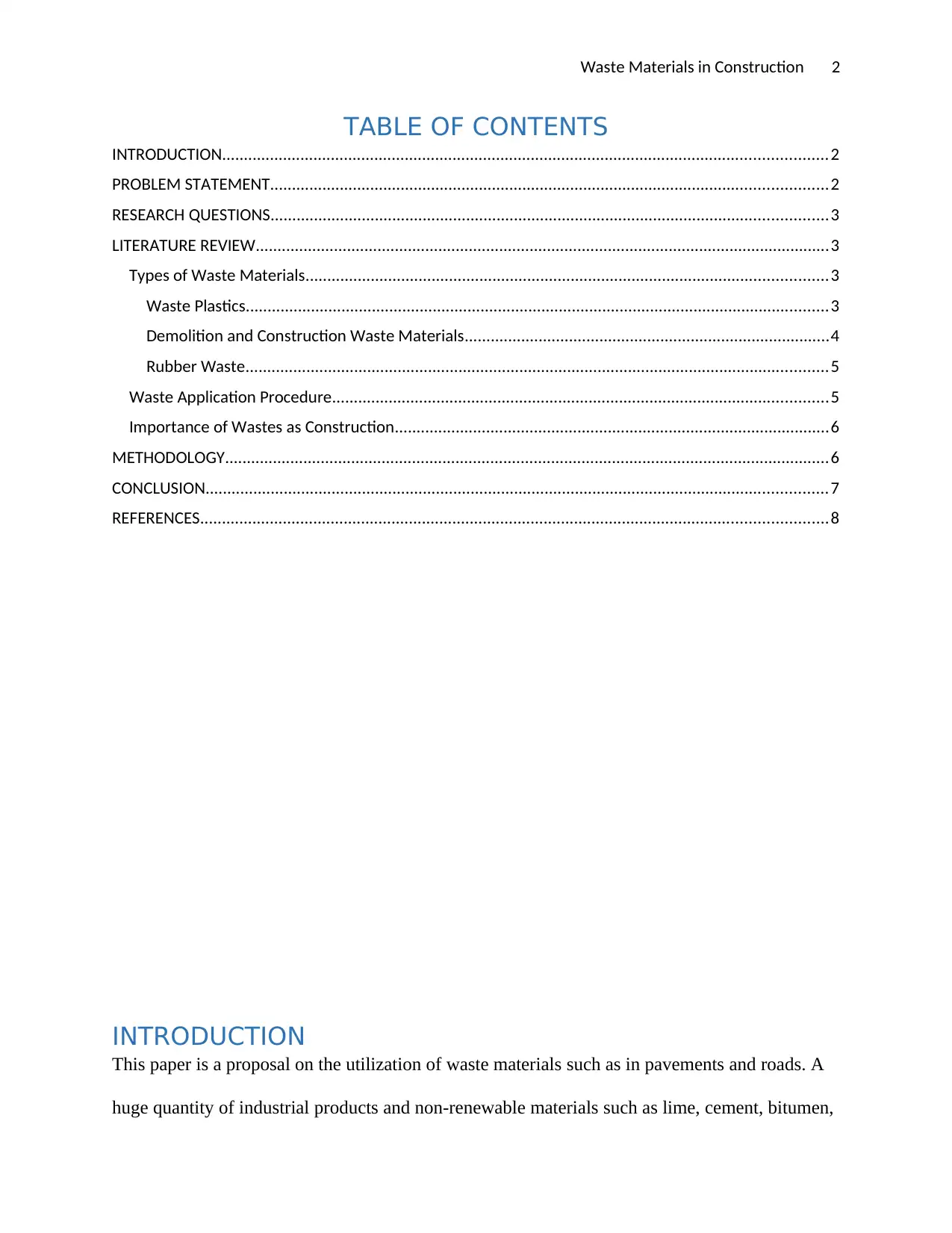
Waste Materials in Construction 2
TABLE OF CONTENTS
INTRODUCTION...........................................................................................................................................2
PROBLEM STATEMENT................................................................................................................................2
RESEARCH QUESTIONS................................................................................................................................3
LITERATURE REVIEW....................................................................................................................................3
Types of Waste Materials........................................................................................................................3
Waste Plastics......................................................................................................................................3
Demolition and Construction Waste Materials....................................................................................4
Rubber Waste......................................................................................................................................5
Waste Application Procedure..................................................................................................................5
Importance of Wastes as Construction....................................................................................................6
METHODOLOGY...........................................................................................................................................6
CONCLUSION...............................................................................................................................................7
REFERENCES................................................................................................................................................8
INTRODUCTION
This paper is a proposal on the utilization of waste materials such as in pavements and roads. A
huge quantity of industrial products and non-renewable materials such as lime, cement, bitumen,
TABLE OF CONTENTS
INTRODUCTION...........................................................................................................................................2
PROBLEM STATEMENT................................................................................................................................2
RESEARCH QUESTIONS................................................................................................................................3
LITERATURE REVIEW....................................................................................................................................3
Types of Waste Materials........................................................................................................................3
Waste Plastics......................................................................................................................................3
Demolition and Construction Waste Materials....................................................................................4
Rubber Waste......................................................................................................................................5
Waste Application Procedure..................................................................................................................5
Importance of Wastes as Construction....................................................................................................6
METHODOLOGY...........................................................................................................................................6
CONCLUSION...............................................................................................................................................7
REFERENCES................................................................................................................................................8
INTRODUCTION
This paper is a proposal on the utilization of waste materials such as in pavements and roads. A
huge quantity of industrial products and non-renewable materials such as lime, cement, bitumen,
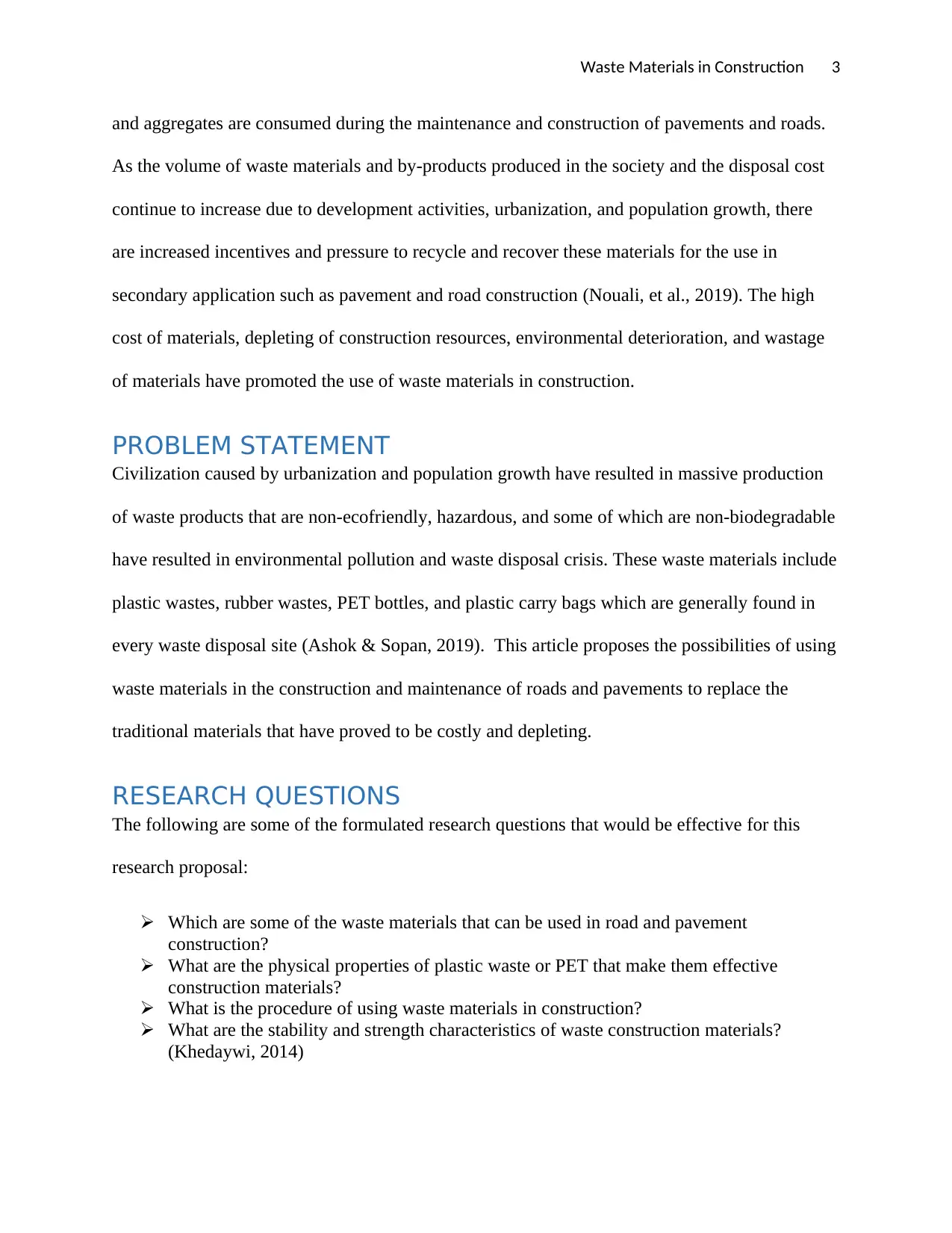
Waste Materials in Construction 3
and aggregates are consumed during the maintenance and construction of pavements and roads.
As the volume of waste materials and by-products produced in the society and the disposal cost
continue to increase due to development activities, urbanization, and population growth, there
are increased incentives and pressure to recycle and recover these materials for the use in
secondary application such as pavement and road construction (Nouali, et al., 2019). The high
cost of materials, depleting of construction resources, environmental deterioration, and wastage
of materials have promoted the use of waste materials in construction.
PROBLEM STATEMENT
Civilization caused by urbanization and population growth have resulted in massive production
of waste products that are non-ecofriendly, hazardous, and some of which are non-biodegradable
have resulted in environmental pollution and waste disposal crisis. These waste materials include
plastic wastes, rubber wastes, PET bottles, and plastic carry bags which are generally found in
every waste disposal site (Ashok & Sopan, 2019). This article proposes the possibilities of using
waste materials in the construction and maintenance of roads and pavements to replace the
traditional materials that have proved to be costly and depleting.
RESEARCH QUESTIONS
The following are some of the formulated research questions that would be effective for this
research proposal:
Which are some of the waste materials that can be used in road and pavement
construction?
What are the physical properties of plastic waste or PET that make them effective
construction materials?
What is the procedure of using waste materials in construction?
What are the stability and strength characteristics of waste construction materials?
(Khedaywi, 2014)
and aggregates are consumed during the maintenance and construction of pavements and roads.
As the volume of waste materials and by-products produced in the society and the disposal cost
continue to increase due to development activities, urbanization, and population growth, there
are increased incentives and pressure to recycle and recover these materials for the use in
secondary application such as pavement and road construction (Nouali, et al., 2019). The high
cost of materials, depleting of construction resources, environmental deterioration, and wastage
of materials have promoted the use of waste materials in construction.
PROBLEM STATEMENT
Civilization caused by urbanization and population growth have resulted in massive production
of waste products that are non-ecofriendly, hazardous, and some of which are non-biodegradable
have resulted in environmental pollution and waste disposal crisis. These waste materials include
plastic wastes, rubber wastes, PET bottles, and plastic carry bags which are generally found in
every waste disposal site (Ashok & Sopan, 2019). This article proposes the possibilities of using
waste materials in the construction and maintenance of roads and pavements to replace the
traditional materials that have proved to be costly and depleting.
RESEARCH QUESTIONS
The following are some of the formulated research questions that would be effective for this
research proposal:
Which are some of the waste materials that can be used in road and pavement
construction?
What are the physical properties of plastic waste or PET that make them effective
construction materials?
What is the procedure of using waste materials in construction?
What are the stability and strength characteristics of waste construction materials?
(Khedaywi, 2014)
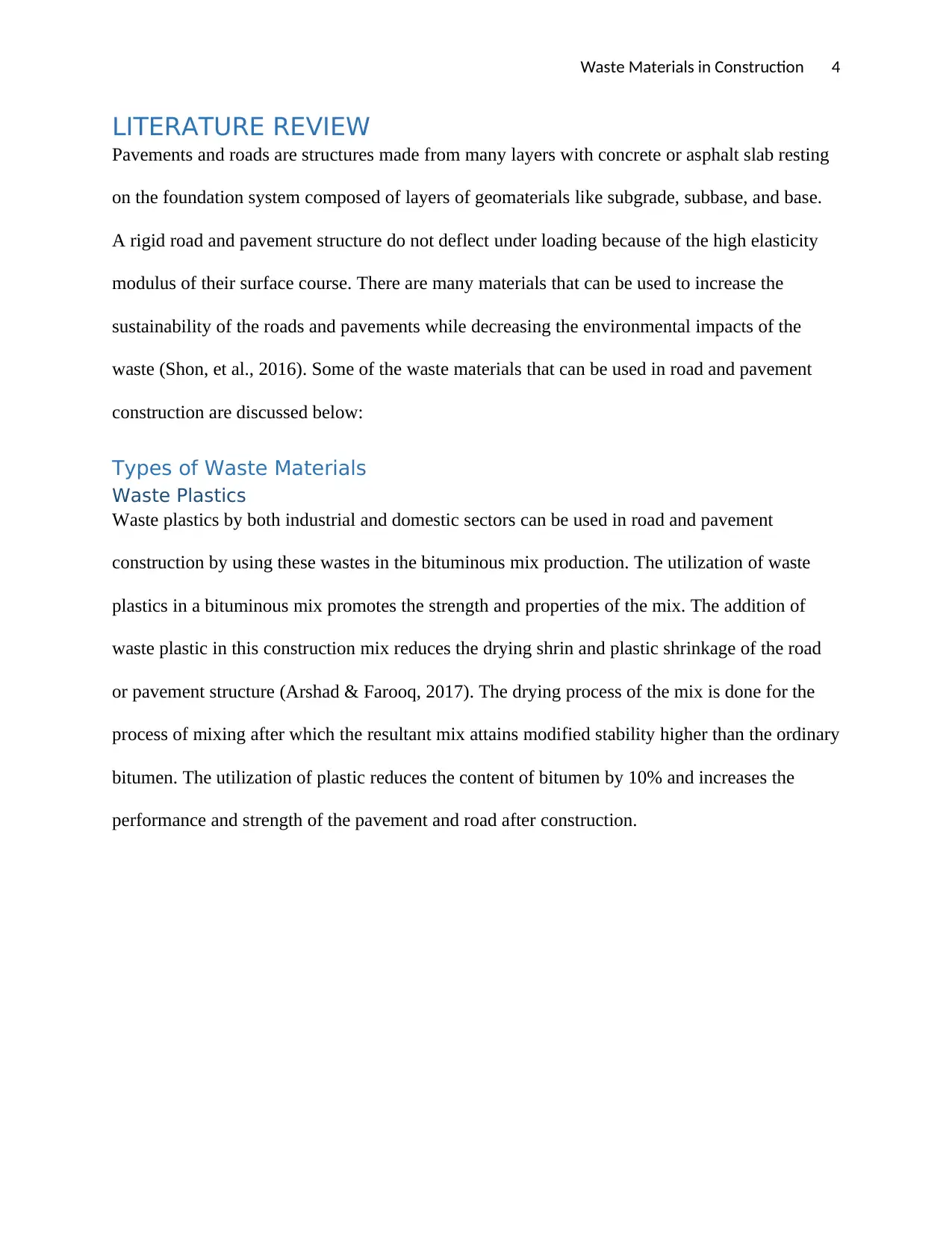
Waste Materials in Construction 4
LITERATURE REVIEW
Pavements and roads are structures made from many layers with concrete or asphalt slab resting
on the foundation system composed of layers of geomaterials like subgrade, subbase, and base.
A rigid road and pavement structure do not deflect under loading because of the high elasticity
modulus of their surface course. There are many materials that can be used to increase the
sustainability of the roads and pavements while decreasing the environmental impacts of the
waste (Shon, et al., 2016). Some of the waste materials that can be used in road and pavement
construction are discussed below:
Types of Waste Materials
Waste Plastics
Waste plastics by both industrial and domestic sectors can be used in road and pavement
construction by using these wastes in the bituminous mix production. The utilization of waste
plastics in a bituminous mix promotes the strength and properties of the mix. The addition of
waste plastic in this construction mix reduces the drying shrin and plastic shrinkage of the road
or pavement structure (Arshad & Farooq, 2017). The drying process of the mix is done for the
process of mixing after which the resultant mix attains modified stability higher than the ordinary
bitumen. The utilization of plastic reduces the content of bitumen by 10% and increases the
performance and strength of the pavement and road after construction.
LITERATURE REVIEW
Pavements and roads are structures made from many layers with concrete or asphalt slab resting
on the foundation system composed of layers of geomaterials like subgrade, subbase, and base.
A rigid road and pavement structure do not deflect under loading because of the high elasticity
modulus of their surface course. There are many materials that can be used to increase the
sustainability of the roads and pavements while decreasing the environmental impacts of the
waste (Shon, et al., 2016). Some of the waste materials that can be used in road and pavement
construction are discussed below:
Types of Waste Materials
Waste Plastics
Waste plastics by both industrial and domestic sectors can be used in road and pavement
construction by using these wastes in the bituminous mix production. The utilization of waste
plastics in a bituminous mix promotes the strength and properties of the mix. The addition of
waste plastic in this construction mix reduces the drying shrin and plastic shrinkage of the road
or pavement structure (Arshad & Farooq, 2017). The drying process of the mix is done for the
process of mixing after which the resultant mix attains modified stability higher than the ordinary
bitumen. The utilization of plastic reduces the content of bitumen by 10% and increases the
performance and strength of the pavement and road after construction.
Secure Best Marks with AI Grader
Need help grading? Try our AI Grader for instant feedback on your assignments.
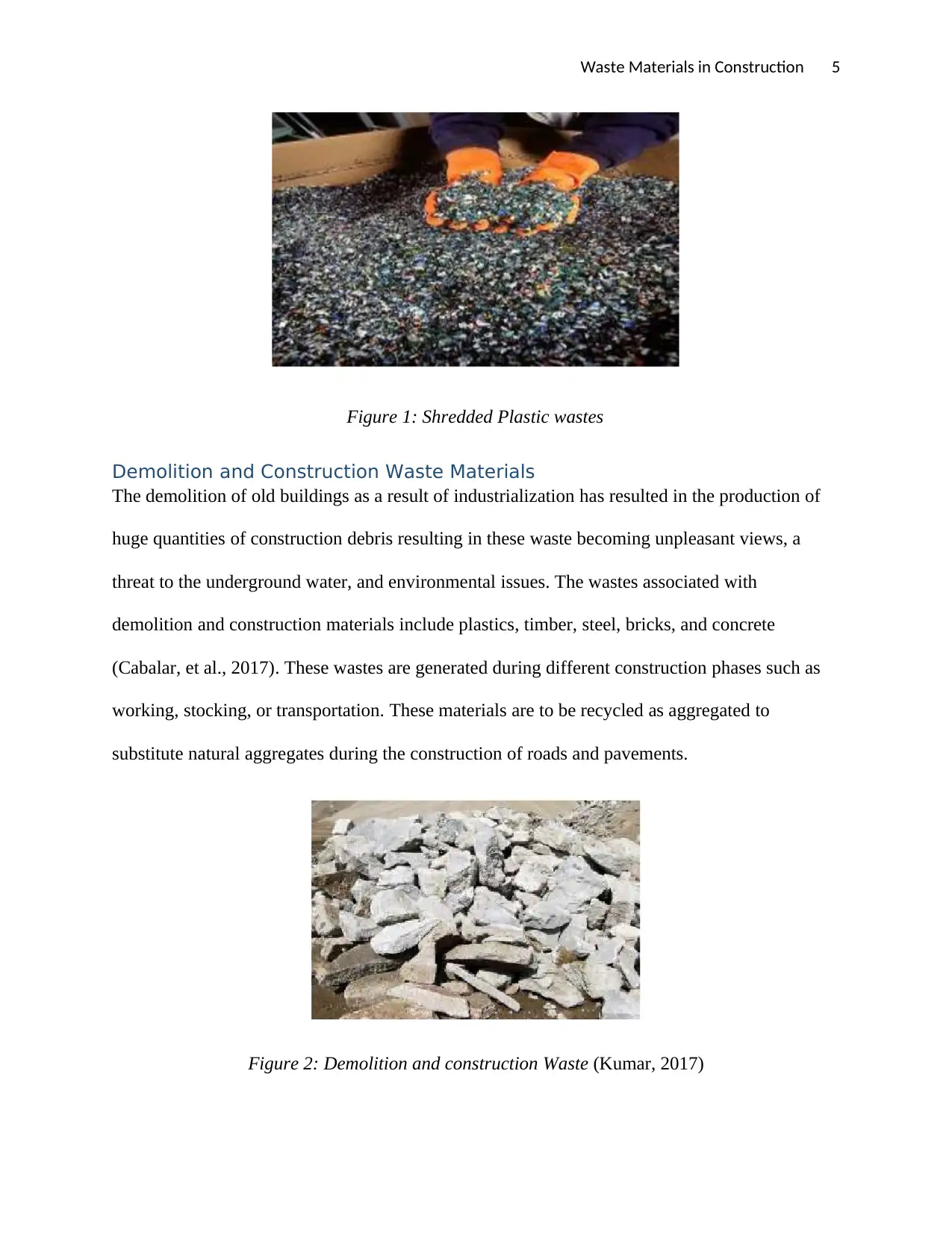
Waste Materials in Construction 5
Figure 1: Shredded Plastic wastes
Demolition and Construction Waste Materials
The demolition of old buildings as a result of industrialization has resulted in the production of
huge quantities of construction debris resulting in these waste becoming unpleasant views, a
threat to the underground water, and environmental issues. The wastes associated with
demolition and construction materials include plastics, timber, steel, bricks, and concrete
(Cabalar, et al., 2017). These wastes are generated during different construction phases such as
working, stocking, or transportation. These materials are to be recycled as aggregated to
substitute natural aggregates during the construction of roads and pavements.
Figure 2: Demolition and construction Waste (Kumar, 2017)
Figure 1: Shredded Plastic wastes
Demolition and Construction Waste Materials
The demolition of old buildings as a result of industrialization has resulted in the production of
huge quantities of construction debris resulting in these waste becoming unpleasant views, a
threat to the underground water, and environmental issues. The wastes associated with
demolition and construction materials include plastics, timber, steel, bricks, and concrete
(Cabalar, et al., 2017). These wastes are generated during different construction phases such as
working, stocking, or transportation. These materials are to be recycled as aggregated to
substitute natural aggregates during the construction of roads and pavements.
Figure 2: Demolition and construction Waste (Kumar, 2017)
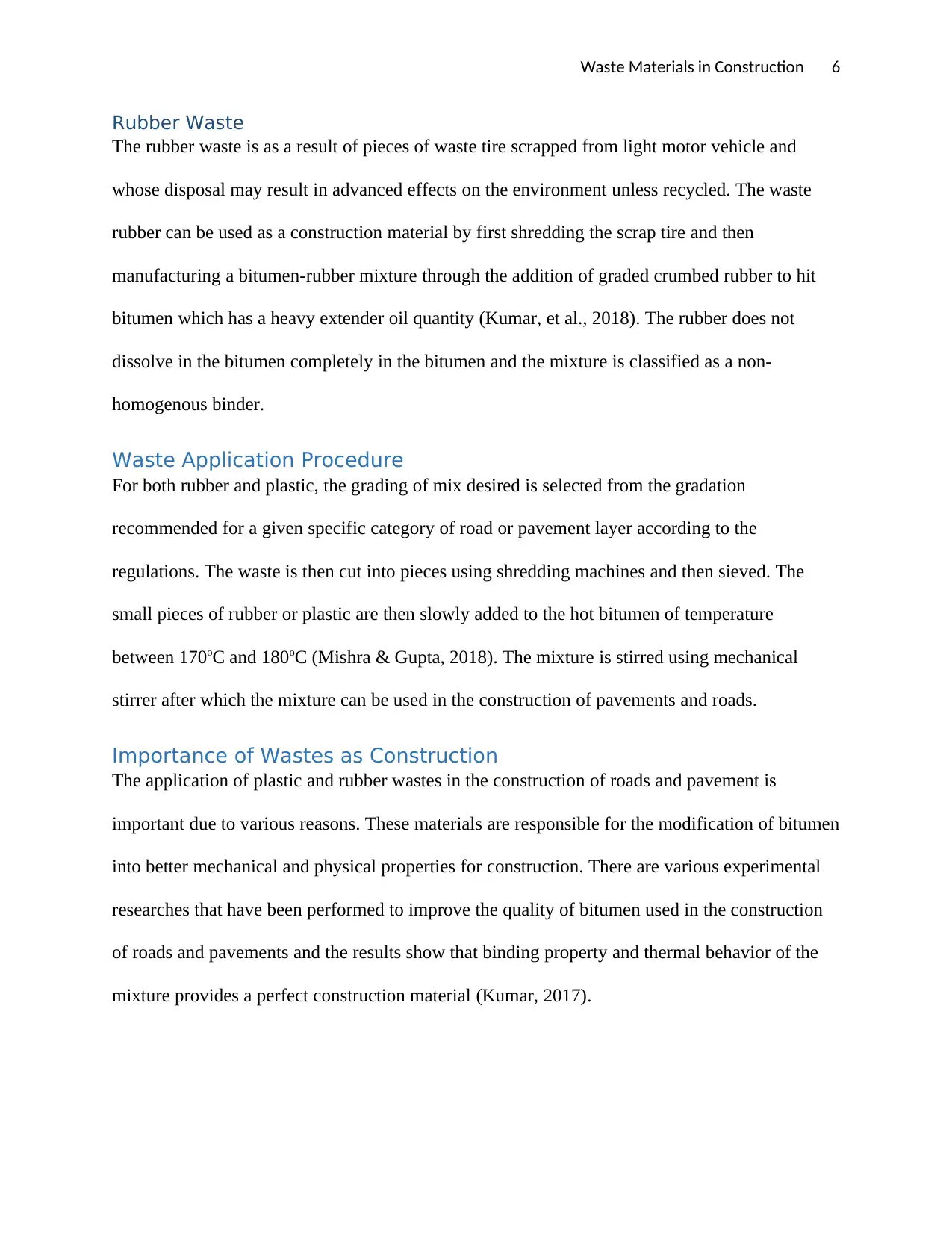
Waste Materials in Construction 6
Rubber Waste
The rubber waste is as a result of pieces of waste tire scrapped from light motor vehicle and
whose disposal may result in advanced effects on the environment unless recycled. The waste
rubber can be used as a construction material by first shredding the scrap tire and then
manufacturing a bitumen-rubber mixture through the addition of graded crumbed rubber to hit
bitumen which has a heavy extender oil quantity (Kumar, et al., 2018). The rubber does not
dissolve in the bitumen completely in the bitumen and the mixture is classified as a non-
homogenous binder.
Waste Application Procedure
For both rubber and plastic, the grading of mix desired is selected from the gradation
recommended for a given specific category of road or pavement layer according to the
regulations. The waste is then cut into pieces using shredding machines and then sieved. The
small pieces of rubber or plastic are then slowly added to the hot bitumen of temperature
between 170oC and 180oC (Mishra & Gupta, 2018). The mixture is stirred using mechanical
stirrer after which the mixture can be used in the construction of pavements and roads.
Importance of Wastes as Construction
The application of plastic and rubber wastes in the construction of roads and pavement is
important due to various reasons. These materials are responsible for the modification of bitumen
into better mechanical and physical properties for construction. There are various experimental
researches that have been performed to improve the quality of bitumen used in the construction
of roads and pavements and the results show that binding property and thermal behavior of the
mixture provides a perfect construction material (Kumar, 2017).
Rubber Waste
The rubber waste is as a result of pieces of waste tire scrapped from light motor vehicle and
whose disposal may result in advanced effects on the environment unless recycled. The waste
rubber can be used as a construction material by first shredding the scrap tire and then
manufacturing a bitumen-rubber mixture through the addition of graded crumbed rubber to hit
bitumen which has a heavy extender oil quantity (Kumar, et al., 2018). The rubber does not
dissolve in the bitumen completely in the bitumen and the mixture is classified as a non-
homogenous binder.
Waste Application Procedure
For both rubber and plastic, the grading of mix desired is selected from the gradation
recommended for a given specific category of road or pavement layer according to the
regulations. The waste is then cut into pieces using shredding machines and then sieved. The
small pieces of rubber or plastic are then slowly added to the hot bitumen of temperature
between 170oC and 180oC (Mishra & Gupta, 2018). The mixture is stirred using mechanical
stirrer after which the mixture can be used in the construction of pavements and roads.
Importance of Wastes as Construction
The application of plastic and rubber wastes in the construction of roads and pavement is
important due to various reasons. These materials are responsible for the modification of bitumen
into better mechanical and physical properties for construction. There are various experimental
researches that have been performed to improve the quality of bitumen used in the construction
of roads and pavements and the results show that binding property and thermal behavior of the
mixture provides a perfect construction material (Kumar, 2017).
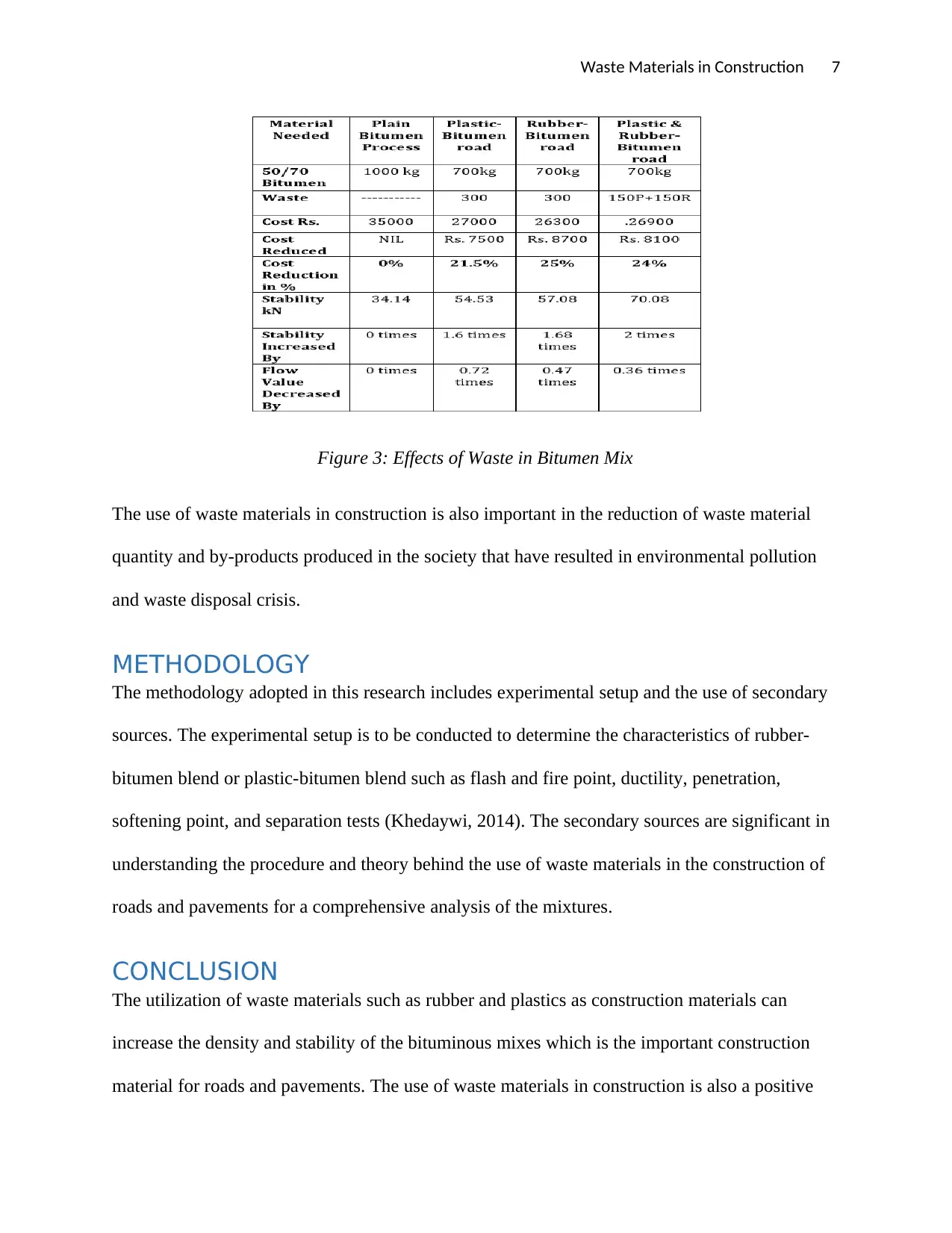
Waste Materials in Construction 7
Figure 3: Effects of Waste in Bitumen Mix
The use of waste materials in construction is also important in the reduction of waste material
quantity and by-products produced in the society that have resulted in environmental pollution
and waste disposal crisis.
METHODOLOGY
The methodology adopted in this research includes experimental setup and the use of secondary
sources. The experimental setup is to be conducted to determine the characteristics of rubber-
bitumen blend or plastic-bitumen blend such as flash and fire point, ductility, penetration,
softening point, and separation tests (Khedaywi, 2014). The secondary sources are significant in
understanding the procedure and theory behind the use of waste materials in the construction of
roads and pavements for a comprehensive analysis of the mixtures.
CONCLUSION
The utilization of waste materials such as rubber and plastics as construction materials can
increase the density and stability of the bituminous mixes which is the important construction
material for roads and pavements. The use of waste materials in construction is also a positive
Figure 3: Effects of Waste in Bitumen Mix
The use of waste materials in construction is also important in the reduction of waste material
quantity and by-products produced in the society that have resulted in environmental pollution
and waste disposal crisis.
METHODOLOGY
The methodology adopted in this research includes experimental setup and the use of secondary
sources. The experimental setup is to be conducted to determine the characteristics of rubber-
bitumen blend or plastic-bitumen blend such as flash and fire point, ductility, penetration,
softening point, and separation tests (Khedaywi, 2014). The secondary sources are significant in
understanding the procedure and theory behind the use of waste materials in the construction of
roads and pavements for a comprehensive analysis of the mixtures.
CONCLUSION
The utilization of waste materials such as rubber and plastics as construction materials can
increase the density and stability of the bituminous mixes which is the important construction
material for roads and pavements. The use of waste materials in construction is also a positive
Paraphrase This Document
Need a fresh take? Get an instant paraphrase of this document with our AI Paraphraser

Waste Materials in Construction 8
step towards tackling waste materials which are known to be non-ecofriendly, hazardous, and
non-biodegradable and have resulted in environmental pollution and waste disposal crisis.
step towards tackling waste materials which are known to be non-ecofriendly, hazardous, and
non-biodegradable and have resulted in environmental pollution and waste disposal crisis.
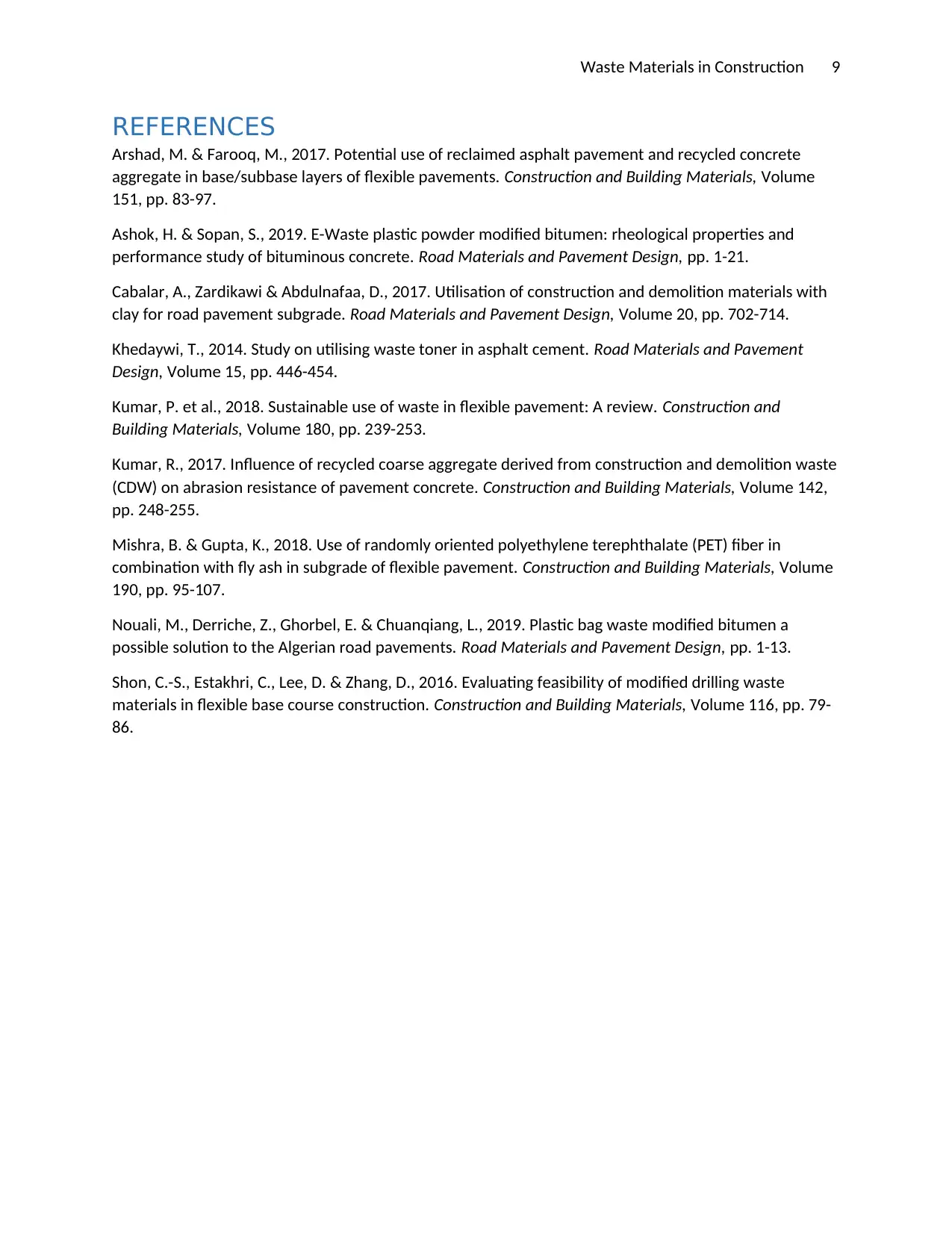
Waste Materials in Construction 9
REFERENCES
Arshad, M. & Farooq, M., 2017. Potential use of reclaimed asphalt pavement and recycled concrete
aggregate in base/subbase layers of flexible pavements. Construction and Building Materials, Volume
151, pp. 83-97.
Ashok, H. & Sopan, S., 2019. E-Waste plastic powder modified bitumen: rheological properties and
performance study of bituminous concrete. Road Materials and Pavement Design, pp. 1-21.
Cabalar, A., Zardikawi & Abdulnafaa, D., 2017. Utilisation of construction and demolition materials with
clay for road pavement subgrade. Road Materials and Pavement Design, Volume 20, pp. 702-714.
Khedaywi, T., 2014. Study on utilising waste toner in asphalt cement. Road Materials and Pavement
Design, Volume 15, pp. 446-454.
Kumar, P. et al., 2018. Sustainable use of waste in flexible pavement: A review. Construction and
Building Materials, Volume 180, pp. 239-253.
Kumar, R., 2017. Influence of recycled coarse aggregate derived from construction and demolition waste
(CDW) on abrasion resistance of pavement concrete. Construction and Building Materials, Volume 142,
pp. 248-255.
Mishra, B. & Gupta, K., 2018. Use of randomly oriented polyethylene terephthalate (PET) fiber in
combination with fly ash in subgrade of flexible pavement. Construction and Building Materials, Volume
190, pp. 95-107.
Nouali, M., Derriche, Z., Ghorbel, E. & Chuanqiang, L., 2019. Plastic bag waste modified bitumen a
possible solution to the Algerian road pavements. Road Materials and Pavement Design, pp. 1-13.
Shon, C.-S., Estakhri, C., Lee, D. & Zhang, D., 2016. Evaluating feasibility of modified drilling waste
materials in flexible base course construction. Construction and Building Materials, Volume 116, pp. 79-
86.
REFERENCES
Arshad, M. & Farooq, M., 2017. Potential use of reclaimed asphalt pavement and recycled concrete
aggregate in base/subbase layers of flexible pavements. Construction and Building Materials, Volume
151, pp. 83-97.
Ashok, H. & Sopan, S., 2019. E-Waste plastic powder modified bitumen: rheological properties and
performance study of bituminous concrete. Road Materials and Pavement Design, pp. 1-21.
Cabalar, A., Zardikawi & Abdulnafaa, D., 2017. Utilisation of construction and demolition materials with
clay for road pavement subgrade. Road Materials and Pavement Design, Volume 20, pp. 702-714.
Khedaywi, T., 2014. Study on utilising waste toner in asphalt cement. Road Materials and Pavement
Design, Volume 15, pp. 446-454.
Kumar, P. et al., 2018. Sustainable use of waste in flexible pavement: A review. Construction and
Building Materials, Volume 180, pp. 239-253.
Kumar, R., 2017. Influence of recycled coarse aggregate derived from construction and demolition waste
(CDW) on abrasion resistance of pavement concrete. Construction and Building Materials, Volume 142,
pp. 248-255.
Mishra, B. & Gupta, K., 2018. Use of randomly oriented polyethylene terephthalate (PET) fiber in
combination with fly ash in subgrade of flexible pavement. Construction and Building Materials, Volume
190, pp. 95-107.
Nouali, M., Derriche, Z., Ghorbel, E. & Chuanqiang, L., 2019. Plastic bag waste modified bitumen a
possible solution to the Algerian road pavements. Road Materials and Pavement Design, pp. 1-13.
Shon, C.-S., Estakhri, C., Lee, D. & Zhang, D., 2016. Evaluating feasibility of modified drilling waste
materials in flexible base course construction. Construction and Building Materials, Volume 116, pp. 79-
86.
1 out of 9
Related Documents
Your All-in-One AI-Powered Toolkit for Academic Success.
+13062052269
info@desklib.com
Available 24*7 on WhatsApp / Email
![[object Object]](/_next/static/media/star-bottom.7253800d.svg)
Unlock your academic potential
© 2024 | Zucol Services PVT LTD | All rights reserved.





